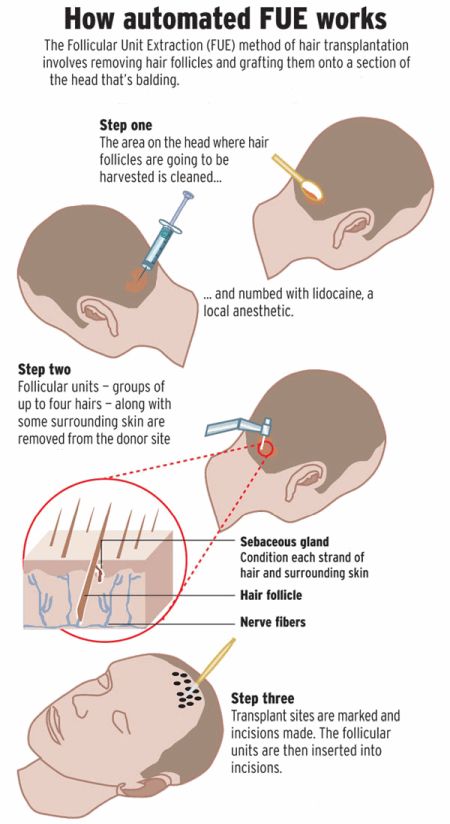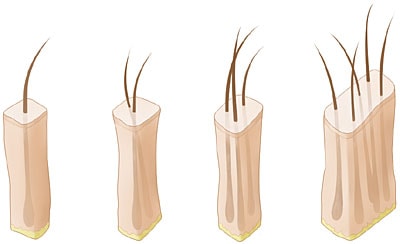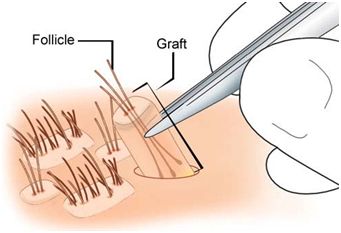
Hair loss, while common, can be upsetting for many people. When nonsurgical treatment methods are insufficient to slow, stop, or restore hair loss, there are other viable options worth considering. Our hair restoration doctors can perform Follicular Unit Extraction (FUE) for patients desiring fuller, natural looking hair. See some of these outcomes in our Testimonials section. FUE is a minimally invasive hair restoration surgery that uses advanced technology to track and extract hair follicles with precise accuracy and control. The process involves using a small (0.8mm - 1.0mm), rounded instrument or “punch” to make a small, round incision in the skin around a follicular unit, isolating it from the surrounding tissue. The unit is then extracted (pulled) directly from the scalp, leaving a small open hole.
This process is repeated until the hair transplant surgeon has collected sufficient follicular units for the planned hair restoration operation. This process can take one or more hours and in large transplant sessions, may be scheduled over two consecutive days. The donor spots, approximately 1mm in size, completely heal over 7 to 10 days, leaving tiny white scars buried in the hair in the back and sides of the scalp.
This method of donor harvesting, removing follicular units one-by-one directly from the scalp, is what separates FUE hair transplant from a traditional FUT (Follicular Unit Transplant), where the donor hair is removed from the scalp in one thin, long strip and then separated into individual follicular units using a stereo-microscope.
During the implant phase of the operation, tiny “recipient sites” are made in the balding area of the scalp using a fine needle-point instrument. The follicular units are then placed into the recipient sites where they will grow into healthy hair-producing follicles. The creation of recipient sites and the placement of follicular unit grafts are basically the same in both FUE and FUT procedures. The difference is in the appearance of the donor area and in the quality and quantity of grafts obtained with each technique.

FUE is recommended for both men and women of all hair colors and textures that do not want an invasive hair transplant approach. It is performed on patients with advanced hair loss, as well as those who wish to increase thickness to thinning areas. Read more about hair loss in men and hair loss in women.
Because FUE does not leave a linear scar, it may be appropriate for patients who want to wear their hair short. It is also an advantage for those involved in strenuous activities, such as professional athletes, who must resume these activities soon after their procedure.
The technique is also useful for those who have mended poorly from traditional strip harvesting or who have a tight scalp. FUE transplants also allow the doctor to potentially remove hair from parts of the body other than the donor scalp, such as the beard or trunk, although there are many limitations with this process.
Perhaps the most straight-forward application of this technique is to disguise a linear donor scar from an earlier hair transplant procedure. In this technique, a small amount of hair is extracted from the area around a linear donor scar and then placed directly into it.
Some patients want Follicular Unit Extraction simply because they heard that it is less invasive than FUT or is non-surgical. The truth is that both procedures involve surgery and in both cases the depth of the incisions (i.e. into the fat layer directly beneath the hair follicles) is the same. The difference is in the kind of incision made. In FUE there are multiple round incisions scattered throughout the donor area and in FUT there is one single, long incision in the middle of the donor area. FUE should be chosen if the multiple round incisions are preferred and not because the technique is “non-surgical.”
What to Expect
With so many promising hair loss treatments available today, it can be difficult to find the best one. Our doctors understand this and it is their goal during the consultation to provide as much information as possible so that every patient feels confident that they are making the best personal decision. The majority of FUE procedures start in the morning at our doctors' surgical facility, and end in the late afternoon — the amount of time varies depending on the volume of hair being transplanted.
Donor Region
During the consultation, your doctor will go over the aesthetic goals of the patient, and be able to give an estimated number of grafts that will need to be extracted to get the desired results. The donor region where the hair will be extracted is in the back of the head, as this is an area where hair growth is constant and permanent. Read more about hair growth and hair loss here. For medium-to-large FUE cases, the whole back and sides of the scalp may need to be shaved. For smaller cases (less than 1,000-1,200 grafts) patients may need to have a only small strip of hair shaved, which will be covered by the hair above it. As a result, the shaved donor regions will not be noticeable at the end of the procedure. The donor hair, removed in follicular units, usually includes groups of about 1 to 4 hairs. The hair removal process is performed in a carefully randomized pattern, so that the hair around the extracted grafts will grow back and hide the virtually undetectable, flat “micro-dots” left from the FUE procedure. Once transplanted, each hair follicle will grow permanently in its new location.

Recipient Sites
In the terminology of hair transplantation, the recipient site is the place that hair is transplanted to correct hair loss. Recipient sites are the tiny slits or holes that the hair transplant doctor makes in the patient’s scalp, where the follicular unit grafts are placed during a hair transplant procedure.

The purpose of hair transplantation is to restore aesthetic balance to a person's appearance - a balance that is lost with balding of the scalp. The hair loss area can become the feature that draws attention away from the face and dominates overall facial appearance.
Primary aesthetic concerns that are addressed include:
The hairline: A recreated hairline should be placed at an aesthetically correct position on the frontal scalp, be natural in appearance, be proper to the patient's age, and be appropriate with the appearance of other original or restored hair on the scalp. The doctor will likewise consider how a recreated hairline will "age" as the patient ages. The hairline should remain appropriate to the patient's age over a period of time; a hairline that looks natural when the patient is 28 should continue to look natural when the patient is 48.
Natural appearance and ease of styling: "Natural appearance" is the key phrase describing hair transplantation today. The type of donor hair selected, graft placement, size of grafts and overall transplant technique are chosen to guarantee that transplanted hair is as "natural" in appearance as the original hair and is amenable to styling as appropriate to the patient's wishes.
Since FUE harvesting requires a much larger area compared to strip harvesting (roughly 5x the area for the same number of grafts) in order to perform large sessions of FUE, the whole donor area must be shaved. This can cause a significant short-term cosmetic problem for many patients. Conversely, with FUT using strip harvesting, the donor incision can be hidden with hair – even with very large sessions.
Since FUE is minimally invasive and doesn't require a scalpel or stitches, there is very little pain after the operation. Most patients can go back to their normal activities within 1 to 2 days, and can continue strenuous activities and contact sports much sooner after the procedure than after a FUT operation. It is essential to follow your doctor’s specific post-operative instructions to ensure effective and proper healing and hair growth. On the first day following the procedure, small scabs the size of a pinhead surrounding the transplanted hair follicles may become noticeable. These scabs typically go away in 7 to 10 days. Patients should see the donor site at the back of the head return to normal in about 7 to 10 days after the operation. A few weeks after surgery, the transplanted follicles enter a resting phase that lasts for 3 to 4 months, and the original hair will fall out to make way for new, healthy hair. This is to be expected. The follicles are alive and healthy under the skin. At this point, most patients will look very much like they did prior to surgery until the new hairs start to grow.
New Hair Growth
New hair growth starts about 3-4 months after the procedure. By 6 months, around half of the newly transplanted hair starts to grow, and by 9 months, almost 80% of the hair grafts will be growing. By 12-18 months, the regions where hair loss once occurred will be filled in with thicker and fuller hair, leaving patients excited about their results.
The cost of FUE will depend on the on the degree of hair loss and the number of grafts needed to reach the patient’s goals. Sometimes, multiple sessions may be needed to get the proper coverage and/or thickness requested. For some patients, 500 grafts are enough to make a noticeable difference. For others, as many as 3,000 or more might be needed to reach the desired results.
How well does it work?
With FUE, natural looking hair restoration is achieved through a delicate touch and allows your doctor the ability to use his artistic eye to create life-changing, permanent results. Patients can wear their hair any length or style, since the transplants produce natural, normal hair growth. It's important to note that hair loss is a progressive disease and that hair transplant surgery does not stop non-transplanted hair from continuing to thin and eventually bald. Therefore, further nonsurgical and/or surgical treatments may be needed to keep up with the rate of continuing hair loss.
Does FUE scar?
The extracted grafts removed during the hair removal process will leave almost unnoticeable, flat “micro-dots”. While FUE does not result in any discernible scarring, these tiny “micro-dot” scars might be visible if the hair is totally shaved. You may shave your hair down to 1/8th of an inch (1 guard on an electric razor) without anybody seeing your scars.
Hair type limitations?
The FUE procedure can be performed on any color and type of hair. During the consultation, your doctor will specify any special requirements that must be taken before surgery.
Primary benefits?
Small graft extraction using the FUE approach offers numerous benefits, including:
Minimally invasive operation without needing a scalpel or stitches
Precise and efficient extraction, collection, and storage of hair grafts
Minimal pain after the operation
Faster recovery
Nearly invisible flat “micro-dot” scarring
Follicular Unit Extraction (FUE) and Follicular Unit Transplantation (FUT) are often compared as if they are two completely different, even competing, hair transplant procedures. Despite this common misconception, the difference between FUE and FUT is the way by which follicular units are removed from the donor region in the back and sides of the scalp. The rest of the hair transplant procedure is basically the same, and the results will appear similar.
However, the harvesting method does have important implications for the hair restoration procedure as it will affect the total number of high quality grafts that can be harvested from the donor region and therefore, the fullness achieved from the hair transplant. In general, the harvesting method of FUT via strip is superior to that of FUE for two main reasons. The first reason is that the FUT procedure allows the doctor to produce the highest quality grafts by isolating the follicle units with minimal trauma (this disadvantage is minimized with Robotic FUE). The second is that FUT enables the doctor to best utilize the most permanent part of the donor region.
While the FUT (“strip method”) procedure produces wonderful results, the FUE procedure is sometimes preferred by patients because it is minimally invasive as it does not involve a scalpel or stitches, nor does it leave any noticeable linear scars at the back of the scalp.
Because the differences between FUE and FUT are significant, the pros and cons of FUE hair transplant surgery should be considered when deciding which procedure is best for you.

If you are experiencing thinning hair or balding and are living with stress over the loss of your hair, we encourage you to contact us now. You can find the answers to the most frequently asked questions here. Our doctors in Korea will give you a thorough consultation and a detailed treatment plan, and provide you with an effective, lasting solution.

Please send us your email address, and one of our representatives will personally contact you as soon as possible.
Your email address will never be sold or spammed.